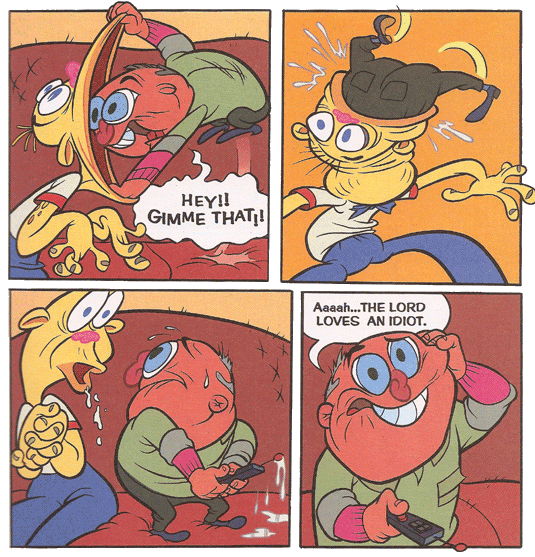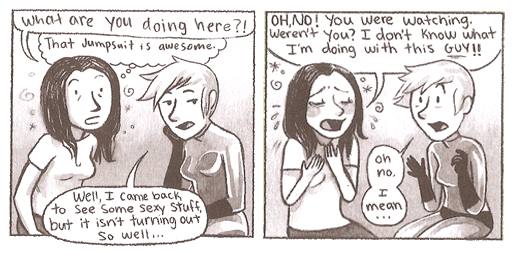

| October 2013 |
|
| John Kricfalusi: Comic Book | |
 This is an oversize, hardcover compilation of Spümco comics; the artists and writers are credited as Jim Smith, Vincent Waller, Mike Fontanelli, Shane Glines, and Rich Pursel, but it's John K's vision and style that shines through, so I'll consider him the creator.
This is an oversize, hardcover compilation of Spümco comics; the artists and writers are credited as Jim Smith, Vincent Waller, Mike Fontanelli, Shane Glines, and Rich Pursel, but it's John K's vision and style that shines through, so I'll consider him the creator.
John K, best known as the creator of Ren & Stimpy, is probably a minority taste. He's a mixture of blinding talent and adolescent fixations... no less than two of the six stories in the book feature extended sequences involving turds. Two center on males gazing, slack-jawed and drooling, at pretty girls; one of these features a close-up of adolescent girl knees that could probably get the artist locked up.
And yet, almost no one in comics can match John K for raw skill. His blog is a treasure trove of information on cartooning and animating. He obsessively studies the greats, staring with Bob Clampett, and he's a stickler for learning the hierarchy of forms in a scene, for harmonious colors, for keeping the drawings lively. He's full of tips, like: don't make the limbs with parallel lines, don't draw both eyes alike, don't draw the facial features too close to the ears.
No one can draw faces with more emotion and comedy. This book is an advanced course in facial (and bodily) expression-- especially the main character, George Liquor (shown at right with Jimmy the Idiot Boy). Most cartoonists fall into a rut, rotating between a dozen set expressions. Every one of John K's panels has a different expression, wild and yet carefully observed.
The sample shows John K at his best. The gag is silly-- Jimmy, given the remote control, eats it, and George has to get it back-- but the execution is hilariously over the top, and yet perfectly clear and controlled. And it's a nice glance at George's character. He's conservative, small-minded, believes in the manly virtues and little else, and yet he has a certain benignity to him. He can't get mad at Jimmy, because idiots can't help themselves.
The best story in the book is about Jimmy's adventures as a "Turtle Food Collector"-- employed to find insects for turtles. The subject allows John K to indulge some of his fascination for gross things without, well, grossing us out. Amusingly, some of the panels are from the bugs' point of view, and feature huge close-ups of what the humans look like to the bugs-- enormous monsters disfigured by pimples, hairs, and ridges of skin.
And yet... well, I think the one lesson John K didn't learn from the Looney Tunes masters was universality. He can teach you how to draw Bugs Bunny, and how to analyze a Bob Clampett gag, but he can't make a character as appealing as Bugs, or a story that gets past his particular style of juvenilia. Still, it's not going to do you any harm, and again, if you draw at all, the technique is amazing.
Edit (2018): Gah... only it turns out, John K can do you harm. He's a sexual harrasser who didn't just obsess over teenage girls, but went out with them. What's disturbing is that there's always been something skeevy about his cartoons— he was not hiding his grossness very hard. Maybe it's just as well that he was also kind of self-sabotaging, so that there isn't a huge body of work we now will want to ignore.
| Jess Fink : We Can Fix It! | |
 If you had a time machine, you'd go back and burst in on your younger self, wouldn't you? In this short graphic novel, Jess Fink lives in The Future, so she puts on a sexy green jumpsuit, borrows her boyfriend's time machine, and goes back to perv out on her younger selves, as well as attempt to keep them from making mistakes.
If you had a time machine, you'd go back and burst in on your younger self, wouldn't you? In this short graphic novel, Jess Fink lives in The Future, so she puts on a sexy green jumpsuit, borrows her boyfriend's time machine, and goes back to perv out on her younger selves, as well as attempt to keep them from making mistakes.
And basically, nothing works according to plan. The sexytimes are rarely as hot as they were in memory ("That was the most painful blowjob I have EVER seen!"), and her younger selves soon get tired of her nagging... they want to make their own mistakes, dammit. Though they're always willing to make out (a perk of time travel H.G. Wells neglected to explore).
The comic doesn't have a hugely profound point, but it's fun and unpretentious, and Fink has a cute style that matches the story perfectly. (And despite what I said about cartoonists' predictability above, she can make her simple faces enormously expressive.)
(What would you do with a time machine? I'm with Fink in that I don't think the past can be usefully changed-- for better or worse, it's what made us what we are. I'm afraid I'd use it for photo reference and recording proto-languages.)
Something I appreciate about Fink's approach: she just concentrates on what she wants to deal with-- the actual interaction between herself and her younger selves (and their friends). There's no attempt to explain the time machine or even work out how it would affect society. This is a good narrative lesson: use the magical macguffins to tell your story; don't write a user manual.
